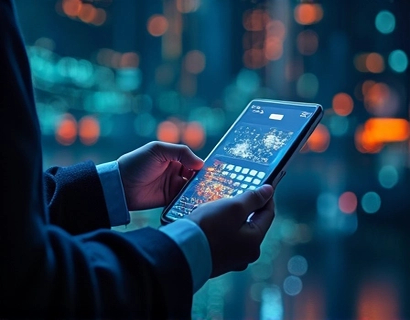Exploring the Future of Accessibility: A Curated Collection of Innovative Universal Apps
The landscape of technology is rapidly evolving, with a growing emphasis on inclusivity and accessibility. The future of accessibility is not just about compliance with standards but about creating innovative solutions that enhance productivity and creativity for users of all abilities. This article delves into a curated collection of groundbreaking apps that redefine what is possible in the realm of universal accessibility. These applications are designed to empower individuals, break down barriers, and make technology universally beneficial.
The concept of universal accessibility goes beyond mere compliance with legal requirements. It involves a deep understanding of diverse user needs and the development of technologies that cater to a wide range of abilities. The apps featured in this collection are a testament to the advancements in this field, offering solutions that are not only functional but also intuitive and user-friendly. From enhancing communication and navigation to boosting creativity and productivity, these apps are transforming the way people interact with technology.
Enhancing Communication: Apps for Seamless Interaction
Effective communication is a cornerstone of productivity and social interaction. For individuals with hearing or speech impairments, traditional communication methods can pose significant challenges. However, innovative apps are bridging these gaps, enabling seamless interaction and connection.
One such app is SignAll, which converts sign language into text in real-time. This app uses advanced computer vision and machine learning algorithms to recognize and translate sign language gestures into written text. Users can communicate more effectively in various settings, from casual conversations to professional meetings. The app is particularly useful in educational environments, where students who are deaf or hard of hearing can participate more fully in class discussions.
Another noteworthy app is Speak Memo, which allows users to convert text to speech and vice versa. This app is invaluable for individuals with speech difficulties or those who need to communicate in noisy environments. Users can record messages, and the app will speak them out loud, ensuring that important information is conveyed clearly. The reverse functionality enables users to listen to spoken words and have them transcribed into text, making it easier to take notes or understand spoken content.
Navigating with Ease: Apps for Enhanced Mobility
For individuals with visual impairments or mobility challenges, navigating the physical world can be daunting. Advanced apps are changing this by providing real-time assistance and enhancing independence.
Be My Eyes is a revolutionary app that connects visually impaired users with volunteers who assist them through a live video call. When users encounter a challenge, such as reading a label or navigating a complex environment, they can request help from a volunteer who provides real-time guidance. This app not only offers practical assistance but also fosters a sense of community and support.
Seeing AI, developed by Microsoft, uses artificial intelligence to describe the world around the user. The app can recognize text, people, and objects, and provide audio descriptions. For example, it can read out text from a sign or a document, identify a person's emotions, and describe products in a store. This app empowers users to navigate their environment more confidently and independently.
Boosting Creativity: Tools for Inclusive Expression
Creativity knows no bounds, and innovative apps are making it possible for everyone to express themselves, regardless of their abilities. These tools break down barriers and open up new avenues for artistic and creative exploration.
Proloquo2Go is a powerful augmentative and alternative communication (AAC) app that helps users with speech impairments express themselves through customizable symbols and text-to-speech functionality. The app allows users to create personalized communication boards and sentences, making it easier to convey thoughts and ideas. With a vast library of symbols and the ability to customize the interface, Proloquo2Go is a versatile tool for creative expression.
Adobe Creative Cloud Accessibility Tools are designed to make creative software more accessible to all users. These tools include features like voice commands, keyboard shortcuts, and screen reader compatibility. For instance, Adobe Photoshop offers a range of accessibility features, such as the ability to navigate the interface using voice commands, making it easier for users with motor impairments to create and edit images.
Increasing Productivity: Apps for Efficient Workflows
Productivity apps are essential for individuals who want to maximize their efficiency and manage their tasks effectively. For users with disabilities, these apps can be tailored to meet specific needs, ensuring that everyone can work at their best.
Microsoft Office Accessibility Features integrate seamlessly into the popular Office suite, providing tools that enhance usability for users with various disabilities. Features like Narrator, which reads aloud text on the screen, and the Magnifier, which enlarges parts of the screen, make it easier for users with visual impairments to work with documents and spreadsheets. Additionally, the Keyboard Shortcuts feature allows users to perform common tasks without relying on a mouse, benefiting those with motor impairments.
Todoist is a task management app that offers robust accessibility features, including screen reader support and customizable keyboard shortcuts. Users can create and manage their to-do lists, set reminders, and collaborate with others effortlessly. The app's intuitive interface and extensive customization options make it a valuable tool for boosting productivity for all users, regardless of their abilities.
Conclusion: A Future of Inclusive Innovation
The apps highlighted in this collection represent just a fraction of the innovative solutions being developed to enhance accessibility and inclusivity. As technology continues to advance, the potential for creating more intuitive, user-friendly, and universally beneficial tools grows exponentially. These applications not only improve the lives of individuals with disabilities but also enrich the experiences of all users by fostering a more inclusive and supportive environment.
The future of accessibility is bright, with ongoing research and development pushing the boundaries of what is possible. By embracing these innovative solutions, we can create a world where technology truly serves everyone, breaking down barriers and unlocking new possibilities for productivity, creativity, and connection.











































